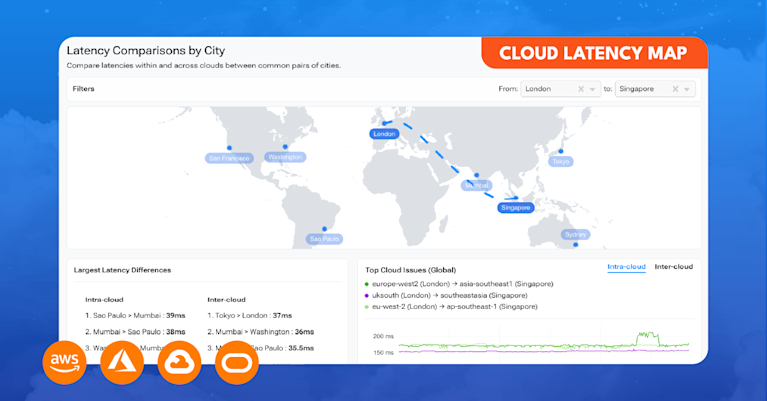Understanding Latency, Packet Loss, and Jitter in Network Performance
Latency, packet loss, and jitter are critical network performance metrics that offer insights into the quality of a network connection. By monitoring and analyzing these metrics, network operations (NetOps) professionals can identify and resolve performance issues, to ensure a seamless and reliable user experience. This article explores the significance of these metrics and explains how Kentik Synthetics can effectively monitor them.
Understanding Data Packets and the Role of IP (Internet Protocol)
Before diving into the metrics, it’s important to understand the concept of data packets and the role of the Internet Protocol (IP) in their transmission. Data packets are the fundamental units of data transmission in a network. When sending data over a network, the information is broken down into smaller chunks called packets. Each packet contains a portion of the data, along with header information that helps network devices route the packet to its intended destination. This header information includes the IP addresses of both the sender and the receiver, which are crucial for proper routing through the network.
IP is a set of rules that govern how data packets are transmitted, routed, and received across networks, including the internet. The IP addresses in the packet headers enable routers and other network devices to determine the most efficient path for the packet to reach its destination. Once the packets reach their destination, they are reassembled to recreate the original data, a process typically handled by the Transmission Control Protocol (TCP) or User Datagram Protocol (UDP) at the transport layer.
Breaking data into packets allows for more efficient and reliable transmission, as individual packets can take different paths through the network to reach the destination, ensuring that the data is delivered even if some network paths are congested or fail.
Network Performance Metrics and their Interdependence
Network performance is often evaluated using three key metrics: latency, packet loss, and jitter. Each of these metrics plays a vital role in determining the overall quality of a network connection, and they often influence one another. Changes in one metric can impact the others, leading to variations in network performance.
What is Latency?: The Delay in Data Transmission
Latency refers to the time it takes for data packets to travel from a source to a destination. High latency can cause delays in data transmission, affecting the other two metrics. If a network experiences high latency, packets may be delayed, causing irregular arrival intervals and increasing jitter.
What is Packet Loss?: When Data Packets Fail to Reach their Destination
Packet loss occurs when data packets fail to reach their intended destination. High packet loss can lead to higher latency, as the sender must retransmit the lost packets, causing additional delays in data transmission. Similarly, a high rate of packet loss can worsen jitter, as missing packets result in an uneven flow of data.
What is Jitter?: The Variation in Latency Over Time
Jitter refers to the inconsistency of data packet arrival intervals or the variation in latency over time. High jitter can cause packets to be received out of order or discarded, leading to packet loss. In some cases, network devices might attempt to compensate for jitter by buffering data, which can further increase latency.
Monitoring all three metrics is essential for NetOps professionals to obtain a comprehensive understanding of network performance. By tracking latency, packet loss, and jitter, network administrators can identify potential issues, prioritize network improvements, and ensure optimal network performance.
The definitive guide to running a healthy, secure, high-performance network

Diving Deeper into Latency, Packet Loss, and Jitter
Let’s further explore the network performance impacts of latency, packet loss, and jitter:
The Significance of Latency Monitoring
Monitoring latency is crucial for maintaining optimal network performance and ensuring a smooth user experience. By keeping track of latency metrics, NetOps professionals can quickly identify and address issues, minimizing disruptions to users and services. Furthermore, understanding the root causes of high latency can help improve network design and capacity planning.
The Role of Packet Loss Measurement and Analysis
Measuring and analyzing packet loss is essential for maintaining a high-quality network connection. Identifying and addressing the causes of packet loss can help improve network reliability and performance, leading to a better user experience. Moreover, understanding packet loss patterns can aid in network troubleshooting and capacity planning.
The Importance of Jitter Measurement and Analysis
Measuring and analyzing jitter is vital for ensuring a stable and reliable network connection, particularly for real-time applications. By identifying and addressing the root causes of jitter, NetOps professionals can optimize network performance and enhance user experience. Additionally, monitoring jitter can help detect potential network issues before they escalate into more significant problems.
Related Kentipedia Articles
- Latency vs Throughput vs Bandwidth: Unraveling the Complexities of Network Speed
- Network Latency: Understanding the Impact of Latency on Network Performance
- Network Performance Monitoring (NPM)
- Network Performance Monitoring Metrics
How Kentik Synthetics Helps Monitor Latency, Packet Loss, and Jitter
Kentik Synthetics is a powerful network performance monitoring solution that enables NetOps professionals to effectively monitor and analyze latency, packet loss, and jitter. With a global network of software agents and the ability to deploy private agents within your own infrastructure, Kentik Synthetics provides comprehensive visibility into your network’s performance.
By continuously running ping and traceroute tests, Kentik Synthetics generates key metrics (latency, jitter, and loss) that can be evaluated for network health and performance. The Test Control Center displays the results graphically, making it easy to identify and resolve issues quickly.
Additionally, Kentik Synthetics supports a wide variety of test types, including agent-to-agent performance meshes, network and routing tests, web tests, autonomous tests, and DNS tests. This flexibility allows NetOps professionals to customize their monitoring strategies to meet their unique network requirements.
Latency, packet loss, and jitter are crucial network performance metrics that can significantly impact user experience. By using Kentik Synthetics to monitor and analyze these metrics, NetOps professionals can ensure optimal network performance and reliability, enhancing overall user satisfaction and ensuring the highest levels of network performance. To experience Kentik’s network latency, loss and jitter monitoring features for yourself, start a free trial or request a personalized demo.


